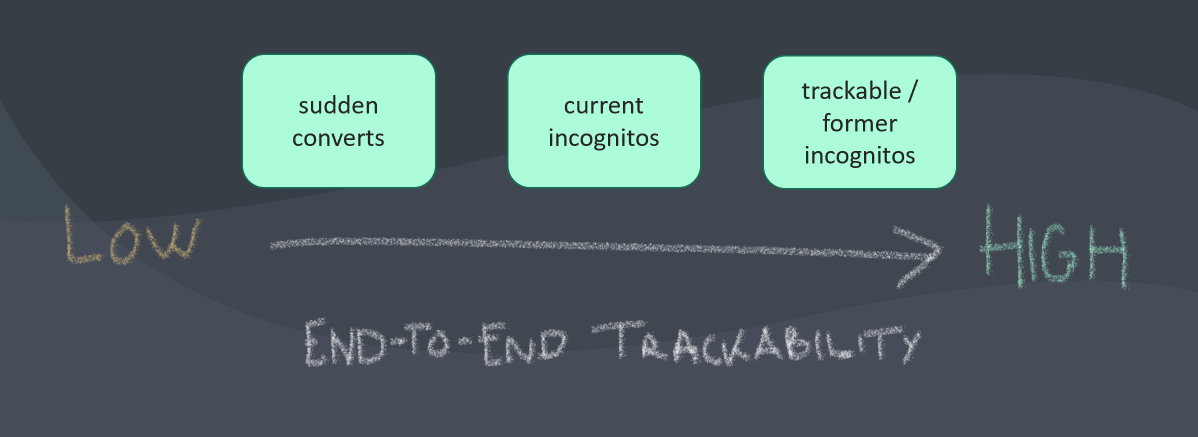Multi-Touch Attribution Models are BS. Multi-Touch Attribution is Not.
We start this blog by stating the obvious. There are two requirements to performant marketing: 1) to generate high quality leads, and 2) to do so as efficiently as possible in terms of resources consumed.
In practice unfortunately, these objectives often get forgotten as marketing teams sustain pressure from the organization. This leads to an outsized focus on lead volume, to the detriment of quality and efficiency. Let’s examine each of these two objectives carefully and try to understand the best way to achieve both.
1. How do we measure the quality of B2B leads?
We won’t kick a dead horse in this post and belabor differing perceptions regarding the quality of leads generated by marketing. Let’s just say there is a clear interface issue that typically remains unaddressed with an ingrained expectation that “this is how things have always been”. But in fact, it doesn’t have to remain this way.
Marketing has many tools at their disposal that help them with evaluating lead quality. A “lead score” is most common. The obvious expectation is that a higher score should correlate with a higher quality lead. The parameters of such scoring are typically set by marketing in response to certain interactions with a lead, such as sending an email to a lead, a lead clicking on an email, etc. A lead score value is thereby increased or decreased by an amount set by the marketer to the extent which s/he believes in something. This is not an objective measure and is highly likely to create idiosyncratic measurement (e.g., someone opening an email multiple times does not suggest that he is X times more likely to become an opportunity than a person who only did it once).
While this approach is directionally correct (i.e. the score increases if someone has looked at an email and lowers if the lead has unsubscribed), the use of wholly subjective weights set by a human reflects this: what a marketer thinks should be; not what really is.
This generally results in a predictable rejection by sales. We think most people would agree that better, objective models are needed to assign a better score. Such models should take into account behavior, demographics, firmographics. They should take into account the characteristics of leads that do and do not convert to paying customers. We also think that most of our colleagues wouldn’t know how to build such engines. The answer: this is a job for a machine, not a human.
2. How does finance (and the rest of your org) evaluate whether leads have been generated economically?
This is where it sometimes gets comical. Marketing tends to fret that they don’t get credit for their hard work (we agree with this, some of it is obscured from sight — more on this below). As a result, vendors bend over backwards to placate marketing (their target buyers) and sell them tools to claim credit for everything that comes in the door.
A worrying trend over the last 5-6 years is the emergence of vendors that create weeks and months of work for the marketing team, encouraging them to configure (invent) a complex “model” under which they will claim credit for pipeline. You must have heard the term of account-based marketing (ABM). It is a sound concept (yes, your outreach effort should be account-centric). But ABM has an ugly stepchild. Here is an example: I sent an email to a person multiple steps removed from the current lead a long time ago; should this be credited as an impactful interaction? A typical answer from marketing attribution tools would be yes or a weighted yes. While this might create good feelings and justify a marketing budget short-term, it makes no sense and amounts to third-party validation of something that has little to do with reality.
Let’s get back to the reason why attribution matters and why we do it in the first place. It has only one purpose: to evaluate the effectiveness of campaigns in order to decide which ones to keep and which ones to drop in the future. Assumptions have no place here, folks, barring some situations (see non-trackable leads below).

Your campaign is either effective, in which case repeating it should be a good thing, or it doesn’t meet the bar you’ve set, in which case doing more of it will likely lose money. Assumptions are proper when you can’t track and measure —or when you have no choice but to have to fill in the gap.
But knowing for a fact that something has happened surely beats any assumption. Let’s also not forget that marketing programs are some of the largest expenses for most B2B businesses. Making decisions for even days or weeks based on false assumptions can be particularly costly here.
Multi-touch marketing attribution is critical for B2B businesses. Multi-touch attribution models are a hindrance, usually a waste of time, and deceitful.
Let us now get deeper into the subject of assessing marketing campaign performance to understand what’s appropriate.
Evaluating campaign performance
Let’s talk about the practical aspects of evaluating campaign performance. A good rule of thumb is to assume that the expense of your campaigns will be directly correlated to the intensity of budget scrutiny you will experience. Your ops and finance functions will cheer for you if you run performant email campaigns. Still, because email campaigns cost little, their attention will be focused on where the real money is, and you will need to defend the spend.
As we discussed above, it’s relatively straightforward with a marketing automation system and CRM which enable tracking, the foundation of a good attribution system. In general, B2B businesses will find that more expensive campaigns tend to have more measurable outcomes (e.g., expensive trade shows produce a list of who you met), but there are some exceptions.
Let’s group and rank all of your leads along the trackability scale, from low to high:

Sudden converts
Congratulations if this is indeed what you get, assuming you have a correctly setup marketing automation system and leads are still coming out of the blue. Typically these would be leads who converted after word of mouth, seeing your billboard on US-101, hearing your company name day after day on NPR, or interacting with an “awareness campaign”. Partner referrals can also appear to be in this category without a robust process. We envy you because your company must have achieved the exalted status of the product selling itself. Hopefully you are at a point where your finance team is more busy counting profits than asking you to support your marketing spend.

For those unfortunate who run campaigns that generate sudden converts but still yet have to defend their spend, we would be remiss by not suggesting a way to measure its results. By the way, operations and finance totally understand the necessity of running such campaigns, assuming they are productive. There are two ways of dealing with elusive metrics.
First: build a landing page or a redirect for such campaigns wherever possible. The impact of your campaign may be spread over multiple pages, but if you have a dedicated page linked to your campaign for the sole purpose of measuring spikes in traffic, this is what you need to make your argument.
Second, if you’re running awareness campaigns, you will need to isolate the impact of such awareness campaigns from the impact of other campaigns and seasonal patterns. This can be difficult.
We believe that a practical way of running such campaigns is to run them in short bursts (say a few days) followed by lulls sufficiently long to taper off the effects of such bursts. Measuring the metrics in the burst and lull intervals gives you a time series of active/inactive periods. If your campaign is effective, ebbs and flows should register as the proof. Also, it is very important to only run one such campaign at a time in order not to average out the competing effects over multiple campaigns.
Perpetual incognitos
This is a subcategory of leads worth mentioning here but that we’ll set aside in terms of the measurement discussion.
These are leads who don’t convert, but who interact with a campaign and whose behavior can be tied to a social identity (or demographic). This almost always requires a social media audience being created (LinkedIn, Facebook). It serves as the basis for retargeting. We don’t get specific email addresses in Salesforce from their interactions. When marketers try to nudge conversion rates at the top of the funnel, they are advised to take advantage of any categorical variables or additional insights made available through social media audience creation.
Current incognitos
Incognito leads come mostly in the form of user activity associated with anonymous site visits from organic search traffic or paid advertisement. Where conversion has yet to occur, you can’t track lead activity end-to-end. In the situation, examining customer browsing patterns, evaluating performance of landing pages vs incoming leads, etc. can often suffice. Just be aware that you control little in this process, and we would prefer to focus resources on things within one’s control, such as site, content, ad targeting, etc. Whatever an average person is doing while browsing through your web site may or may not be reflective of the behavioral patterns of the group who you want to become your customers.
Trackable leads, including former incognitos
This is frequently where a lot of marketing dollars are spent. Fortunately, there is no need to assume anything about a lead’s journey to becoming a customer. At the risk of repetition: it is of little value to embark on a large project to assign weights to each touchpoint. The result will reflect nothing but the subjective opinion of a person assigning the value, and will be useless for resource allocation decisions. Plus you still need the lead to convert (e.g. fill a form) to associate it with an opportunity or deal.
Instead, you can just use your marketing automation platform (Hubspot, Marketo, etc.) to establish this association. The tracking code will associate anonymous behavior to the lead upon conversion. The simplest campaign tracking is all that’s needed for a platform like QFlow.ai to extract, aggregate and present actual customer acquisition touchpoints.
Multi-touch attribution allows you to find many interesting things about your business. Examples may include that
- the trade show you participated in created a large number of leads, but none became customers (sound familiar?)
- the webinar you are running does not help you acquire new leads but instead helps with your existing customers,
- some obscure program you are running actually contributes well above its weight.
Multi-touch attribution models do not help you discover these insights. Instead, they help teams discover that there was a better use of their time than setting them up.
Too many companies get lured into the mindset that they need a multi-touch attribution model, when all they need is multi-touch attribution.
Go Forth and Simplify
We recognize that marketing is in equal parts art and science. Our observation having used many marketing tools in a B2B context is that they frequently tend to overcomplicate things that should be relatively simple. They simultaneously miss the mark regarding the essential goals of B2B marketing stated above: higher quality, higher quantity leads for the best price possible. We like products that are simple to use, intuitive, and generate verifiable results. Multi-touch attribution models are none of the above. The focus should be on integrations and ensuring a modicum of data integrity. Unfortunately multi-touch attribution models in B2B fall under the definition of pseudoscience, in our humble opinion. Happy marketing!


